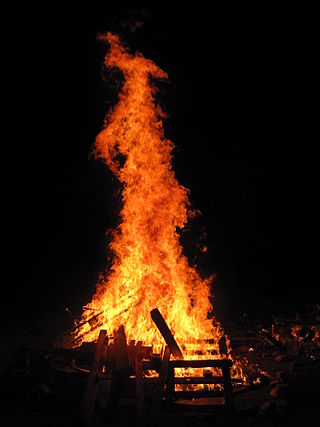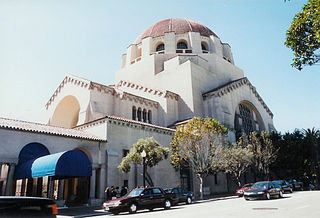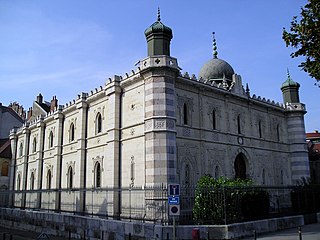
Iyar is the eighth month of the civil year and the second month of the Jewish religious year on the Hebrew calendar. The name is Babylonian in origin. It is a month of 29 days. Iyar usually falls in April–May on the Gregorian calendar.

Tisha B'Av is an annual fast day in Judaism, on which a number of disasters in Jewish history occurred, primarily the destruction of both Solomon's Temple by the Neo-Babylonian Empire and the Second Temple by the Roman Empire in Jerusalem.

Neologs are one of the two large communal organizations among Hungarian Jewry. Socially, the liberal and modernist Neologs had been more inclined toward integration into Hungarian society since the Era of Emancipation in the 19th century. This was their main feature, and they were largely the representative body of urban, assimilated middle- and upper-class Jews. Religiously, the Neolog rabbinate was influenced primarily by Zecharias Frankel's Positive-Historical School, from which Conservative Judaism evolved as well, although the formal rabbinical leadership had little sway over the largely assimilationist communal establishment and congregants. Their rift with the traditionalist and conservative Orthodox Jews was institutionalized following the 1868–1869 Hungarian Jewish Congress, and they became a de facto separate denomination. The Neologs remained organizationally independent in those territories ceded under the terms of the 1920 Treaty of Trianon, and are still the largest group among Hungary's Jews.

Bevis Marks Synagogue, officially Qahal Kadosh Sha'ar ha-Shamayim, is an Orthodox Jewish congregation and synagogue, located off Bevis Marks, Aldgate, in the City of London, England, in the United Kingdom. The congregation is affiliated to London's historic Spanish and Portuguese Jewish community and worships in the Sephardic rite.

Congregation Emanu-El is a Reform Jewish congregation and synagogue, located at 2 Lake Street, in San Francisco, California, in the United States. Founded in 1850, the congregation is one of the two oldest Jewish congregations in California, and one of the largest Jewish congregations in the United States. A member of the Union for Reform Judaism, Congregation Emanu-El is a significant gathering place for the Bay Area Jewish community.

The Jewish people of Bosnia and Herzegovina are one of the minority peoples of Bosnia and Herzegovina, according to country's constitution. The history of Jews in Bosnia and Herzegovina spans from the arrival of the first Bosnian Jews as a result of the Spanish Inquisition to the survival of the Bosnian Jews through the Holocaust and the Yugoslav Wars. Judaism and the Jewish community in Bosnia and Herzegovina have one of the oldest and most diverse histories of all the former Yugoslav states, and is more than 500 years old, in terms of permanent settlement. Then a self-governing province of the Ottoman Empire, Bosnia was one of the few territories in Europe that welcomed Jews after their expulsion from Spain.

Syrian Jews had predominantly two origins: those who inhabited Syria from early times and the Sephardim who fled to Syria after the expulsion of the Jews from Spain and Portugal in 1492 CE. There were large Jewish communities in Aleppo, Damascus, and Qamishli for centuries. In the early 20th century, a large percentage of Syrian Jews immigrated to Palestine, the U.S. and Latin America. The largest Syrian-Jewish community is now located in Israel and is estimated to number 80,000.
David Feuerwerker was a French Jewish rabbi and professor of Jewish history who was effective in the resistance to German occupation the Second World War. He was completely unsuspected until six months before the war ended, when he fled to Switzerland and his wife and baby went underground in France. The French government cited him for his bravery with several awards. After the war, he and his wife re-established the Jewish community of Lyon. He settled in Paris, teaching at the Sorbonne. In 1966, he and his family, grown to six children, moved to Montreal, where he developed a department of Jewish studies at the University of Montreal.
Antoinette Feuerwerker was a French jurist and an active fighter in the French Resistance during the Second World War.
Shangarai Chasset, also called Shaarei Chesed, was an Orthodox and later, Reform, Jewish congregation and synagogue, located in New Orleans, Louisiana, in the United States. The congregation worshipped in the Sefardi rite.
Rose Warfman was a French survivor of Auschwitz and member of the French Resistance.
The Old Yishuv were the Jewish communities of the region of Palestine during the Ottoman period, up to the onset of Zionist aliyah and the consolidation of the New Yishuv by the end of World War I. In the late 19th century, the Old Yishuv comprised 0.3% of the world's Jews, representing 2–5% of the population of the Palestine region.

The Grande synagogue de Lyon is a synagogue located at 13 quai Tilsitt in the 2nd arrondissement of Lyon. This neo-Byzantine Jewish place of worship was built between 1863 and 1864 and renovated for the first time in 2014. It was classified as a monument historique in 1984.

The beginnings of the history of the Jews in Besançon go back to the Middle Ages, a period during which the Jews settled in the city attracted by its activity as a commercial place. The community was founded at the end of the 14th century and, due to its status as a free imperial city, Besançon remained one of the only territories in present-day France to tolerate Jews after their expulsion from the kingdom of France in 1394. The community was nevertheless expelled in turn from Besançon in the middle of the 15th century. The Jews made a tentative return to the city in the 18th century, but it was only after the French Revolution, which emancipated them, that their situation in the Franche-Comté capital stabilized. Although the Jewish community never exceeded 2,000 people except on the eve of the Second World War, it experienced great economic success during the industrial revolution at the end of the 19th century, when the Lipmann family founded LIP, a brand of watchmaking which then became one of the economic engines of the region and remained associated with the name of the city.
Samuel Jacob Rubinstein was a 20th-century French orthodox Chief Rabbi independent from the Consistoire central. He was born in Poland.

Schneour Zalman Schneersohn (1898–1980) was a Lubavitch Hasidic Chief Rabbi who was active in France during World War II. During the Nazi occupation of France, he ran homes for children who had been separated from their families, providing them with food, shelter, and a Jewish education. Later, as the situation in France worsened, he smuggled many of them to safety.

The Synagogue de Nazareth is situated on the Rue Notre-Dame-de-Nazareth, in the 3rd arrondissement of Paris, and is the oldest of the 'great' synagogues of Paris. It is normally known as Synagogue Nazareth rather than Synagogue de la rue Nazareth, its official name.

The New Synagogue was an Ashkenazi synagogue in Shanghai, China, opened in 1941 to serve the city's then growing Russian Jewish community. It was located on rue Tenant de la Tour in the Shanghai French Concession. The synagogue was closed in 1965 after the departure of most Jews from Shanghai following the Communist victory in China, and was repurposed as the auditorium of the Shanghai Institute of Education. It was demolished in the 1990s.
The Israelite Seminary of France also known as the Central Rabbinical School of France , is a Rabbinical school that trains Orthodox rabbis in France. Founded in Metz in 1829 as the Central Rabbinical School of Metz, it moved to Paris in 1859, where it is based in the city's 5th arrondissement. The school is connected with the Israelite Central Consistory of France, one of the major bodies of Orthodox Judaism in France.
Ezekiel Judah or Yehezkel Yehuda or Yahuda or Ezekiel Judah Jacob Sliman was a Jewish communal leader, trader of indigo, muslin, and silk, philanthropist, and talmudist of Baghdad. He migrated to India, leading the Baghdadi Jewish community of Kolkata in his lifetime and establishing the city's first synagogues.













